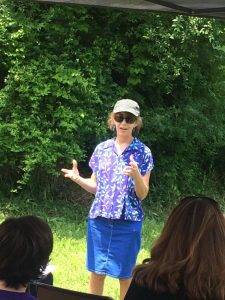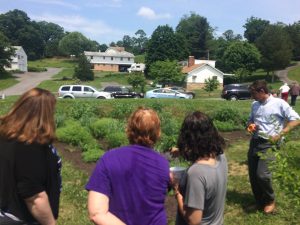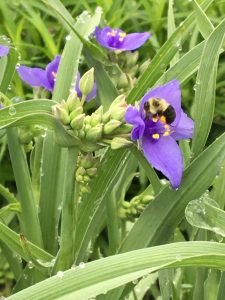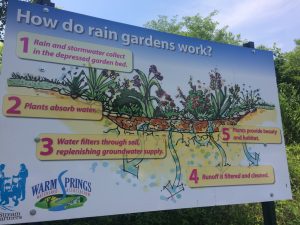Earlier this week, more than forty people met at Greenway Cemetery located in Berkeley
Springs, West Virginia, to celebrate the culmination of five years of work done by several local environmental organizations to address the problem of storm water runoff in the
hilly twenty-nine acre section of the cemetery located west of Johnson Mill Road.

Left to right: Rebecca MacLeod (Town of Bath Planning Commission President), State Senator Charles Trump, Elizabeth Nellums (National Fish and Wildlife Foundation), Kate Lehman (Warm Springs Watershed Association), Kathleen Stotler (Senator Shelley Moore Capito’s Office) Frank Rodgers (Cacapon Institute), Jennifer Pauer (WVDEP), Elizabeth Skinner (Town of Bath Council Member) (Photo: Angela Petry)
“Stormwater runoff in that area can be so severe that on one occasion a recently
buried coffin was washed out of the grave and transported to a neighboring lawn,” said Kate Lehman, president of the Warm Springs Watershed Association. “While this was a onetime event, erosion has long wrecked havoc throughout the area, especially on the three roads in this section of the cemetery.”
Erosion was the main impetus leading the Town of Bath Cemetery Management and
Maintenance Corporation and the Warm Springs Watershed Association to apply for a grant from the National Fish and Wildlife Foundation, which receives funding from the US Environmental Protection Agency.

Rebecca MacLeod (Town of Bath Planning Commission President) spoke about stormwater planning. (Photo: Angela Petry)
Over the years, the watershed association has been awarded additional grant funds by the Stream Partners program, which receives funding from the West Virginia Department of Environmental Protection.
The Town of Bath Tree Board has been awarded grant funds from the Chesapeake Bay Communities Grant program, which receives funds from the West Virginia Division of Forestry.
These funds were used to install various green storm water best management practices in this section of the cemetery.
“The goal of green storm water management is to capture as much water as possible, to slow the descent of whatever water cannot be captured, to direct released water to an area downhill where it can be stored and absorbed, and to filter whatever water is ultimately released into nearby streams,” Lehman said.

Left to right: Kathleen Stotler (Senator Shelley Moore Capito’s office), Kate Lehman, Codi Ford (Town of Bath Cemetery Management and
Maintenance Corporation), Matthew Pennington (Region 9 Eastern Panhandle Regional and Development Council) observe Greenway Cemetery rain garden. (Photo: Angela Petry)
“Without intervention, the smooth, hard surface of a road acts as the perfect conduit for stormwater runoff, causing erosion to the surface of the road.”
“Swales, which were installed on each side of the main road, and diverters, were installed on the northernmost road, move the water away from the road and direct it toward the rain garden located at the lowest point in this section of the cemetery.”
Lehman said that the rain garden collects an estimated 100,000 gallons of stormwater runoff during an average rainfall.
The sandy soil of the rain garden filters and cleans any runoff that does make it to Warm Springs Run. Flowers planted in the rain garden will bloom for nine to ten months of the year, thus enhancing the beauty of the area while providing pollen for bees, butterflies and other pollinators.

Spiderwort and friend at Greenway Cemetery Rain Garden (Photo: Rebecca MacLeod)
Over the past five years, more than 100 trees have been planted in the cemetery,
many of them along the sides of the main road.
The leaves of a mature tree will collect the first three-quarters of an inch of rain in an average rainfall. Some of the rain collected in the leaves will evaporate back into the atmosphere. The remaining rain is slowed in its descent to the ground, which reduces the potential for erosion.
Reducing the amount of eroded materials carried by runoff lessens the severity of
flooding downsteam.
Sediment that collects in the bed of a stream takes up space – with less space in the stream, water will overflow the banks, causing flooding.

(Photo: Angela Petry)
“Reducing the severity of flooding is good for the Town of Bath, which is located in
the floodplain of Warm Springs Run,” Lehman said. “Reducing the amount of eroded materials in Warm Springs Run is also good for the Potomac River, into which the run empties. A cleaner Potomac is good for communities that use water from the river. A cleaner Potomac is also good for the Chesapeake Bay, into which it empties. A cleaner Bay is good for everyone.”
